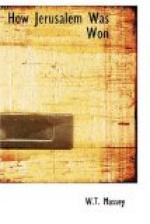It was about this time the Corps Commander framed plans for the advance of our front north of Jerusalem. There had been a few days of fine weather, and a great deal had been done to improve the condition of the roads and communications. An army of Egyptian labourers had set to work on the Enab-Jerusalem road and from the villages had come strong reinforcements of natives, women as well as men (and the women did quite as much work as the men), attracted by the unusual wage payable in cash. In Jerusalem, too, the natives were sent to labour on the roads and to clean up some of the filth that the Turks had allowed to accumulate for years, if not for generations, inside the Holy City. The Army not merely provided work for idle hands but enabled starving bodies to be vitalised. Food was brought into Jerusalem, and with the cash wages old and young labourers could get more than a sufficiency. The native in the hills proved to be a good road repairer, and the boys and women showed an eagerness to earn their daily rates of pay; the men generally looked on and gave directions. It was some time before steam rollers crushed in the surface, but even rammed-in stones were better than mud, and the lorry drivers’ tasks became lighter.
General Chetwode’s plan was to secure a line from Obeid, 9000 yards east of Bethlehem, the hill of Zamby covering the Jericho road three miles from Jerusalem, Anata, Hismeh, Jeba, Burkah, Beitun, El Balua, Kh. el Burj, Deir Ibzia to Shilta. The scheme was to strike with the 53rd and 60th Divisions astride the Jerusalem-Nablus road, and at the same time to push the 10th Division and a part of the 74th Division eastwards from the neighbourhood of Tahta and Foka. The weather again became bad on December 14 and the troops suffered great discomfort from heavy rains and violent, cold winds, so that only light operations were undertaken. On the 17th the West Kent and Sussex battalions of the 160th Brigade stalked the high ground east of Abu Dis at dawn, and at the




